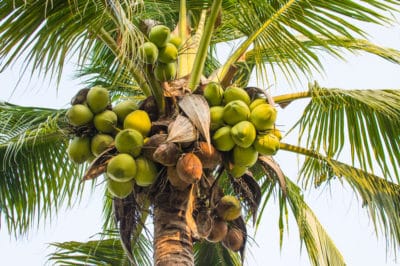Coconut Palm Characteristics
Coconut palms are single trunked trees, with slender trunks and typically swollen at their base. Basic characteristics of the tree include:
- Height & Spread: The palm tree grows up to 60 feet tall and 25 wide at maturity.
- Foliage: Evergreen, yellowish-green to green foliage, with pinnately compound, feather-shaped fronds growing up to 17 feet long.
- Trunk: Depending on the type, coconut palm trunks can be curved or straight with grayish bark.
- Flowers: Yellowish flowers form on canoe-shaped sheaths that can be 3 feet long with approximately 10 branchlets in spring. Male flowers are smaller than females and form on the end of the branchlets, whereas females form at the base.
- Fruits: Coconut palms can produce up to 200 coconut fruits annually and it takes up to a year for them to ripen. A thick, fibrous husk surrounds the inner nut of the coconut, containing the milk and white flesh. While immature, fruits are green and when ripe, change to a brownish color.
Preferred Climate
Coconut palms grow well in USDA zones 10 and 11, where frosts and freezes aren’t common. If you live in zone 9, you can still grow a coconut palm, especially in southern most areas of the zone, but don’t be disappointed if an unexpected hard freeze kills the tree, which are sometimes common in this zone.
Frost Protection
Due to the large size of coconut palms, it’s impossible to protect the tree during an expected freeze by covering it with blankets or holiday lights. However, planting it in the warmest location of the landscape, and thoroughly watering the root system before cold weather arrives, keeps the roots warm during the cold snap.
Uses in the Landscape
If you are fortunate enough to live in an area where coconut palms thrive, they make majestic and fruit-producing additions to the landscape. They work well used as a single accent or specimen tree, or planted in multiples.
The palm also works well used to frame an area, planted in the background, or anywhere in the landscape to add a tropical effect. Don’t plant a coconut palm close to a structure, walkway, or driveway where falling coconuts can potentially damage people or vehicles.
